One of the greatest parts of ramps are their leaves, they're big, beautifully elliptical and a deep shade of forest green that screams "Spring is here!" One of the most popular ramp recipes is a pesto made from leaves. Read on and I'll explain the details, of which there are a few. This is the same ramp pesto recipe I used to serve in my restaurants.
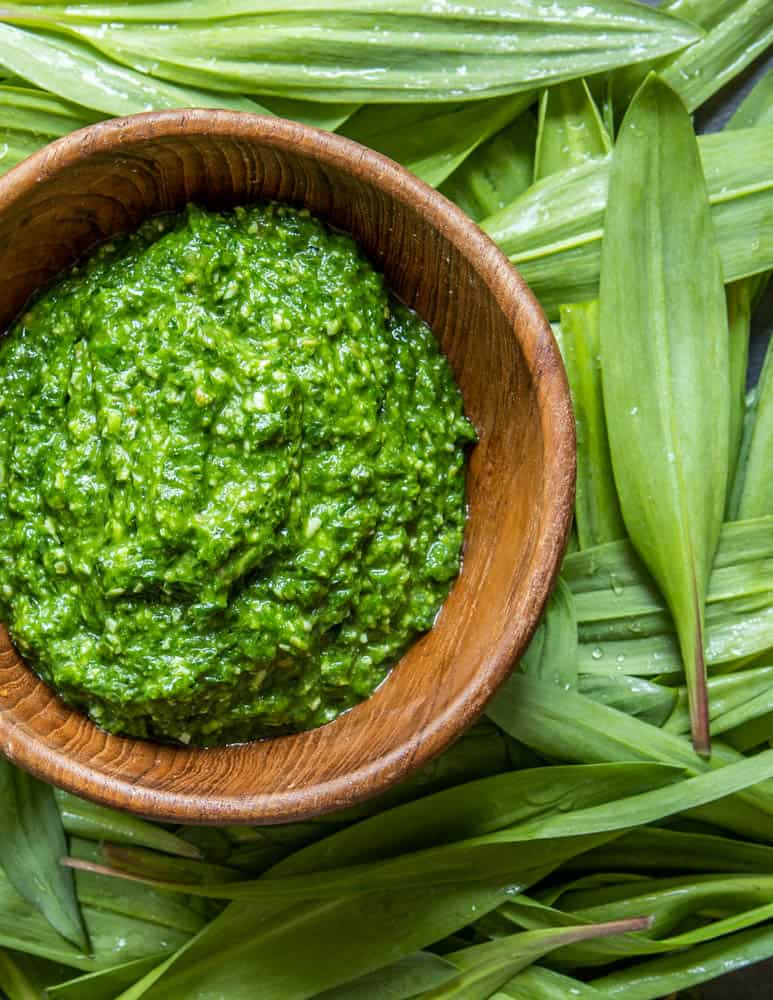
But, with how popular ramps are, everyone needs to pitch in and do their share to make sure that ramps stay here for the future, since they grow slowly, and if all the ramps get picked from a patch, there won't be any left for anyone else to forage. Making ramp pesto is a delicious way to do that.
You don't need to dig up ramp bulbs to make pesto, and that's the best part about making it--there's no digging involved. From a sustainability point too, digging up ramp bulbs means that the plant is gone, and won't be coming back. Leave the bulbs in the ground and you can come back for more leaves year after year without worrying.
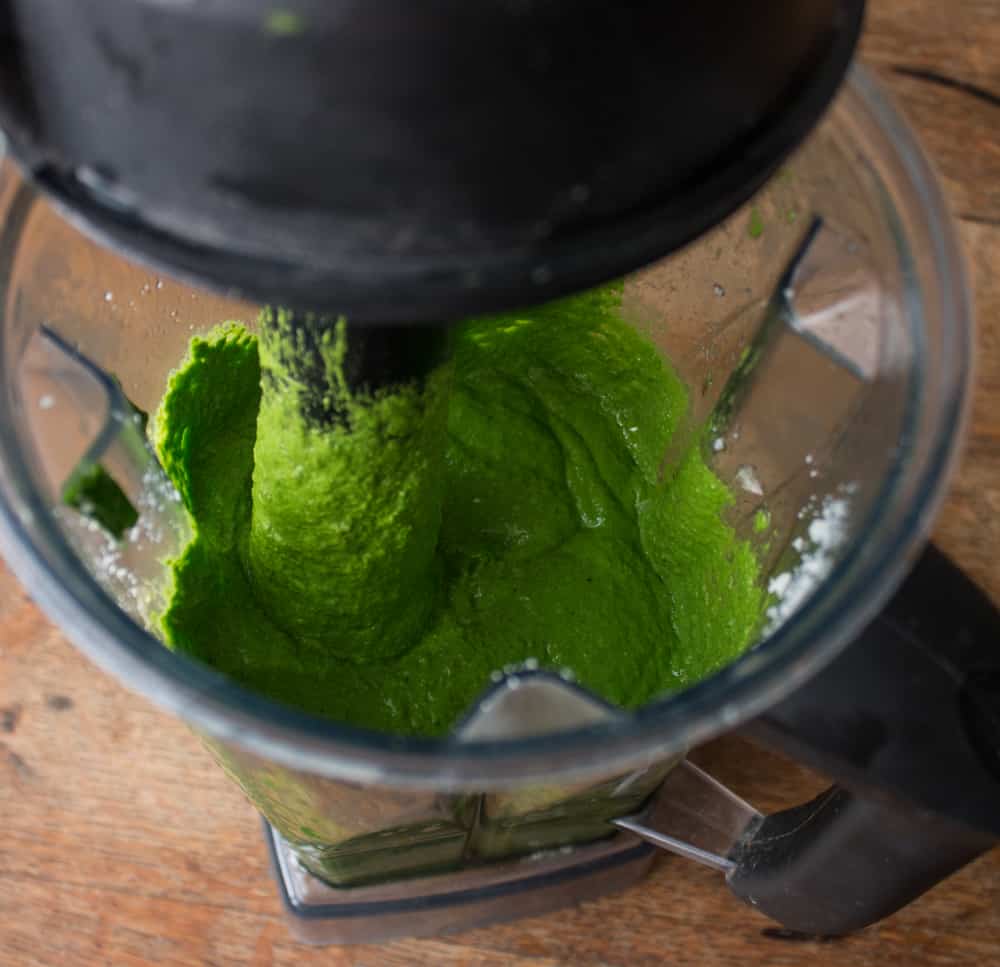
There's plenty of recipes for ramp pesto you can find online, and the quality can vary. Some I've seen are just adaptations or recipes passed along "telephone game style" from another website. Some also contain vague proportions, which through simple misunderstandings, could ruin your expensive batch of ramps.
This is my recipe, and it's the same one I make for restaurants, it's fool proof, but comes with a couple points I'm picky about too. Here's some key technique points you won't see on amateur websites.
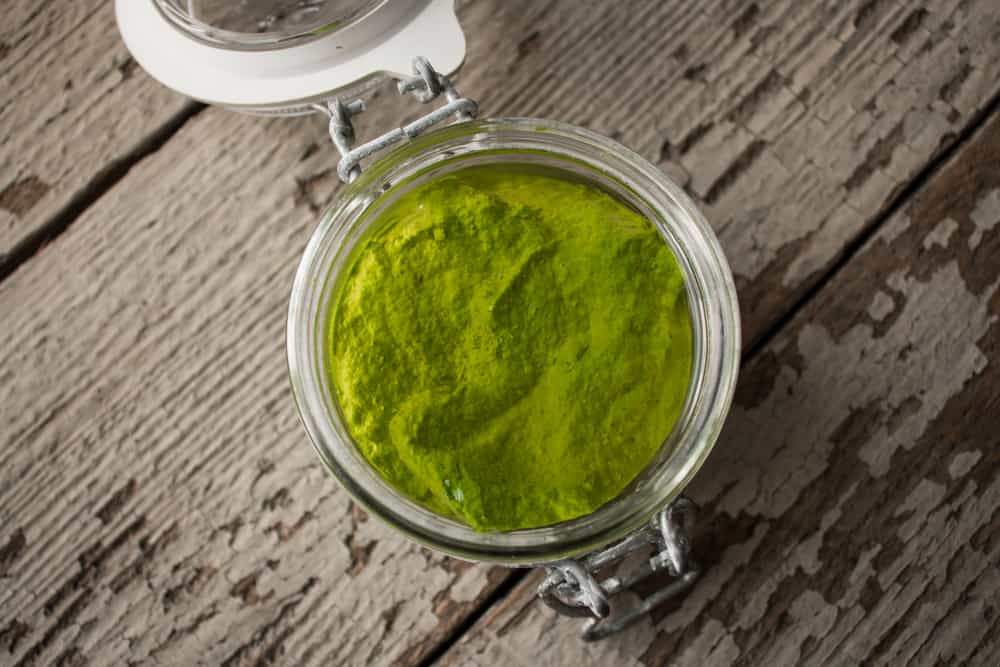
Tips
- Avoid too much texture, and stringy pieces by finely chopping the leaves before blending
- Don't over-puree. Mix the pesto too long and it will ruin it and turn it brown
- Don't put too much stuff in it. It should be far and away mostly ramp leaves by volume
After your pesto's done, you need to take care of it. Aside from the aforementioned guidelines, if a line cook wants to piss me off, a great way to do that is to leave the container of pesto unwrapped and exposed to air, which turns the top brown, dries it out, and can cause it to spoil.
At home you can press plastic wrap directly on the surface of the pesto, or, if it's easier, cover the top with a thin layer of oil, as shown in my pictures.
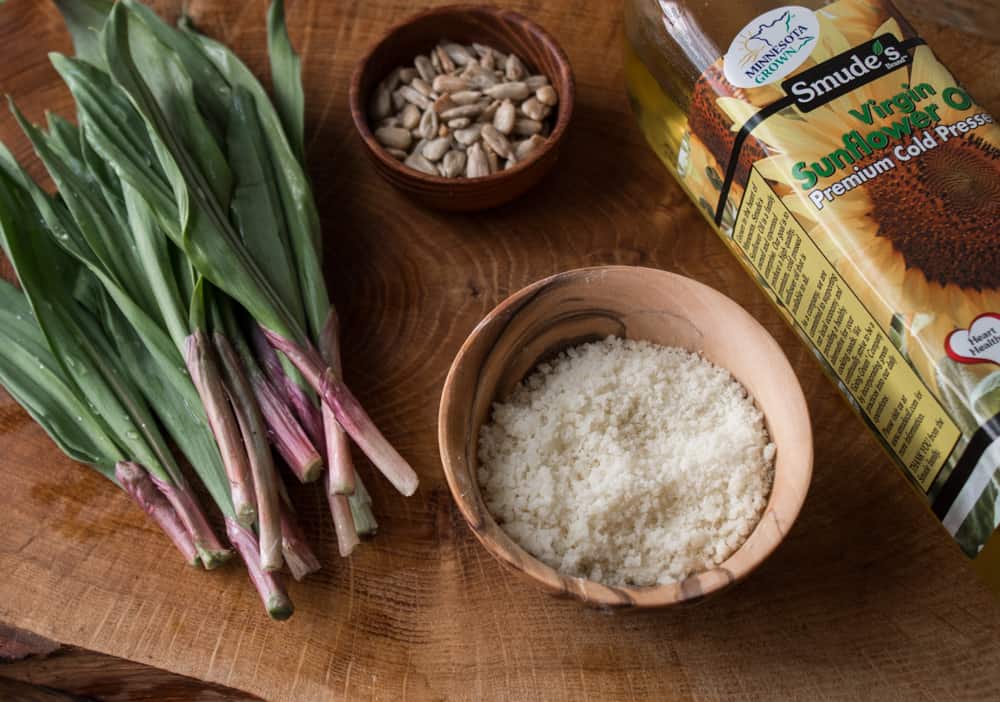
Typically pesto is made with pine nuts, and differs from it's French cousin pistou in that it includes cheese (I've nearly come to blows over this, for the record, pistou doesn't contain cheese). As far as the pine nuts go, they're expensive.
But I have a fun way around them. Back when I was sous chef at St. Paul's famous Heartland restaurant, with it's daily changing, hyper-local menus, every year we made a Midwestern ramp pesto and I grew to love it.
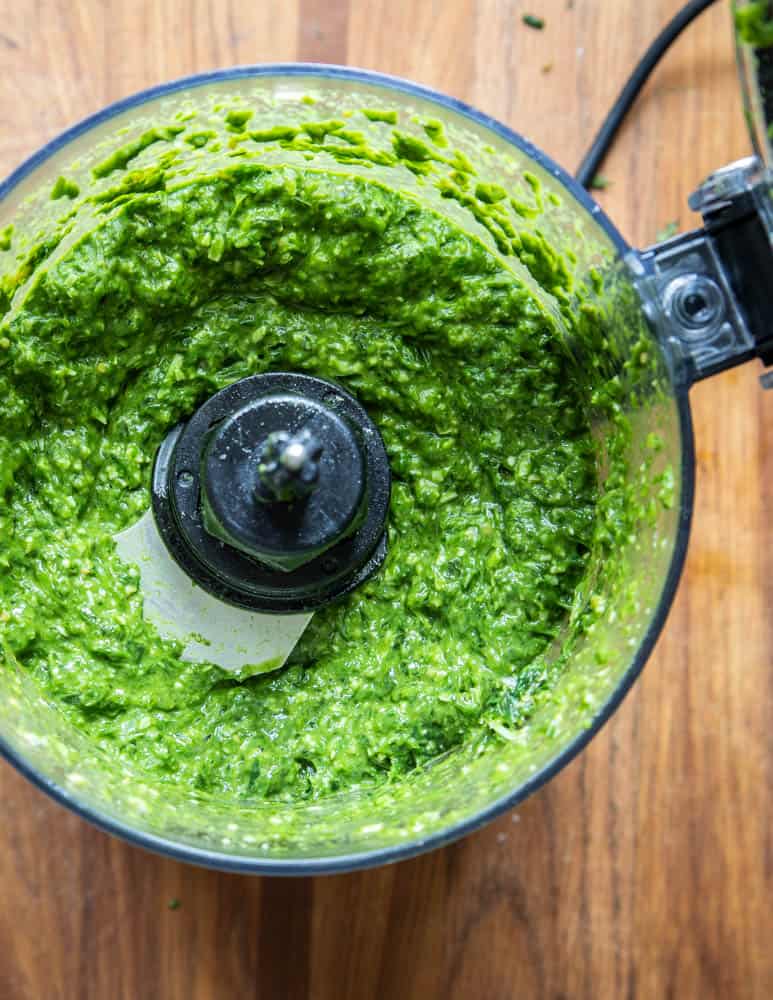
Sunflower seeds are just about the closest thing in structural composition to pine nuts I know of, and they're also a fraction of the cost. Smude's virgin sunflower oil from Pierz Minnesota is an amazing product, I call it the olive oil of the Midwest. Using these adds a Minnesota touch I like, but you can substitute whatever you want, they're your ramps, after all.
Similar Recipes
If you like pesto as much as I do, you should make sure to try Stinging Nettle Pesto with pumpkinseeds too, and Wild Ramp Butter.
Ramp Leaf Pesto
Equipment
Ingredients
- 8 oz fresh ramp leaves washed and cleaned
- 1 heaping tablespoon sunflower seeds or pine nuts
- ½ cup Smude's sunflower oil or another good tasting oil or extra virgin olive oil
- 3 tablespoons parmigiano reggiano or another high quality parmesan you like
- A dash of lemon juice optional
Instructions
- Heat the oven to 350 or so, toast the sunflower seeds until they are aromatic and lightly golden, a few minutes. Cool and reserve.
- Roughly chop the ramp leaves.
- For a milder flavor, blanch half of the ramp greens in boiling water for a few seconds, then chill in a bowl of cold water and squeeze dry.
- In the bowl of a food processor, combine the chopped ramp leaves, toasted sunflower seeds, cheese, and oil. Begin the pureeing process by pulsing to break things up, then keep going until you get a smooth-ish paste.
- After pureeing, if the pesto isn't creamy, fluffy and light, drizzle in some more oil and continue to puree until velvety smooth, this recipe is made for restaurant and highspeed blenders, if you don't have one, you may need to add small amounts of oil/liquid to get it smooth. Double check the seasoning and adjust as needed, then refrigerate or freeze.
Video
Notes
- If you want the pesto coarse, don't puree it completely--it's up to you. I often make it smooth since I'll be adding other garnishes to dishes when the pesto is used.
- A great way to preserve this is to fill ice cube trays with ramp pesto, freeze them, then pop out the cubes and freeze those for easy portioning, I like to use re-useable vacuum bags. Vacuum sealing the cubes will give the longest shelf life.
- The lemon is optional, but the citric acid helps preserve the color.
Nutrition
More
Ramps: Harvesting, Sustainability, Cooking and Recipes

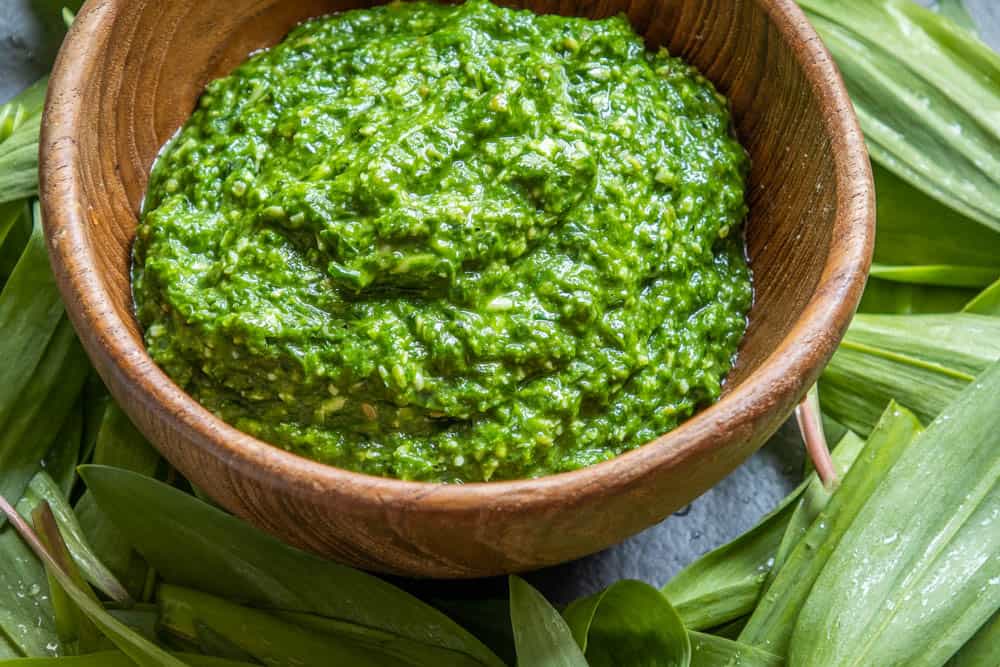
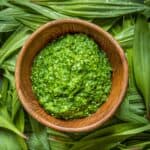
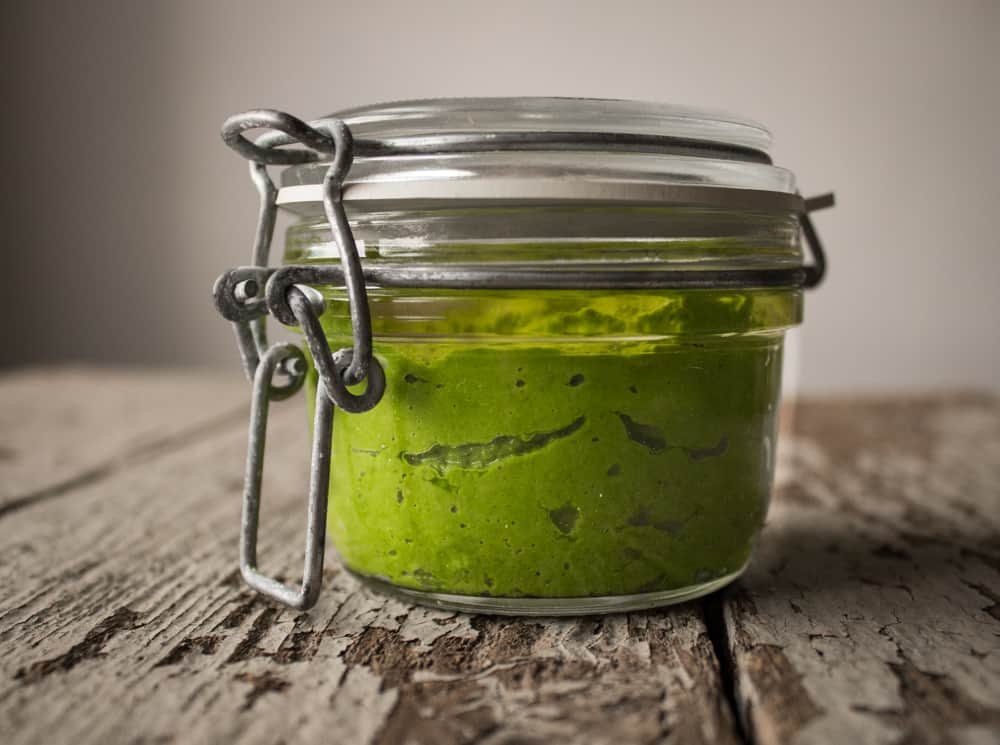
Camille
I was finally able to forage ramps for the first time this year after years and years and years of only being able to purchase them from NYC farmers markets. I followed the ratios in this recipe exactly except I misread "sunflower seeds" for sesame seeds, which I already had in my pantry. So I subbed those instead. I blanched half of the ramps as directed. Made a bright and beautiful pesto! I did opt to include the lemon squeeze, and I also added a couple dashes of kosher salt at the end. I always freeze my basil pesto at the end of the summer by putting it into ice cube trays and then transferring the cubes into a ziplock bag to store in the freezer and preserve a taste of summer all throughout the winter. I've done the same with my ramp pesto and I'm excited to enjoy this taste of spring throughout the summer months! Thank you!
Alan Bergo
Thanks Camille, how did the sesame turn out in it? Ramps do well with Asian flavors so that could be fun.
Camille
It was good! My blender managed to grind most of the seeds even though it’s just a crappy home blender. I might have had a creamier result if I’d ground them before blending or if I’d used sunflower seeds as directed. I was pleased with the flavor though!
Karen
Hello forager chef. I am wondering if the 8 oz of ramps is half a pound (weight) or one cup? I foraged ramps for the first time last week and am grateful to come across your knowledge and recipes. I used this recipe tripling it (assuming the 8 oz meant cups) and while it was delicious everyone said the ramp flavor could be stronger
Alan Bergo
You need to use the weight here. 8 oz of ramps is one cup, but only after cooking or pureeing would they fit in a cup. 1 cup of raw ramp leaves is only a few ounces.
Erika
I tried this but subbed walnuts and olive oil for the sunflower ingredients. I found the resulting pesto very grassy, with very little allium aroma, although with some heat and sharpness in the taste. Is this to be expected? And will the grassiness mellow with age or if added to a recipe where it gets some additional heat (like tossing with hot cooked pasta)?
Alan Bergo
First I’d ask if you’ve cooked with ramps before. This recipe is the same one I used to use in my restaurants, and it’s also in my book, so it’s well tested. Did you double check the seasoning for salt to make sure it tastes good to you? That’s important too. Cook with it and try using it. Tossed with warm pasta or just spread on hot toast it is excellent. I do use more of it than basil pesto, and I should probably clarify that.
Collet
I have some pepitas, I'm thinking they would work as an alternative to the sunflower seeds. What are your thoughts. I just got a pound of ramps and I want to pickle the bulbs and your recipe for the using just the leaves is want I wanted.
Alan Bergo
Collet, that’s just fine.
I’ve made a lot of different combinations of different herbs, nuts and cheese, and I can’t remember a bad one. Just make sure to toast the pepitas well, I would also grind them up before putting in the food processor, otherwise they might not beak up.
Susan
Loved this recipe! I'll make it again. My only issue using my Vitamix was that I used 1/2 the quantities called for in the recipe and I wasn't able to get the pesto smooth in the blender. There was not enough to fully process. Any trick I should know about? I was using the regular VItamix jar and could try using the smaller one that is more upright that II typically use for seeds.
Alan Bergo
Hi Susan! While a Vita works, and it's what I used in restaurants for many years to make this, I eventually changed this recipe to specifically call for a food processor, because pesto is better when it isn't a super smooth puree-a little texture adds interest to it. If you want to use a vitamix, you'll need to increase the size of the batches.
Smoghat
I just bought a large mortar and pestle since I wanted to make pesto the way Italians do, but with basil out of season haven’t used it yet. I am curious, why are you recommending a food processor or Vitamix for ramp pesto.
Alan Bergo
I recommend a food processor first, and a Vitamix second. A mortar and pestle is traditional, sure, but most people will get a sore arm from trying to hard-grind the mixture. It also bruises the leaves and makes a finished product that will be less-green. With ramps too, it's easier for them to be stringy if you were to hand-grind them. I use a molcajete (basalt mortar) mostly for grinding toasted spices.
Smoghat
Hey, thanks for writing back long before I set out to make dinner! Ok, I'll use a food processor. I work out a lot so I'll save the mortar and pestle for basil pesto the italian way.
Steven
Hi Chef,
For the key techniques you mentioned, "Blanch and shock at least some of your ramp greens for a milder flavor, and to lock in the green color." However, your actual recipe directs that all the greens to be blanched. Do you happen to mix the blanched leaves and raw leaves for more assertive flavor? If so, what would be the ratio? Also, will adding the raw leaves will turn the pesto brown? And perhaps, freezing the pesto in a vacuum bag also helps to keep the color?
Alan Bergo
Thanks for pointing out that typo. Use 50/50.
Steven Kang
I got 2 lbs of ramps today. And thank you for the recipe update. I will make this! And perhaps...will make your visually striking salsa verde, although I got no Vitamix.
Alan Bergo
Good deal. You can use a regular blender for the salsa V.
Alexandra
I used this recipe for inspiration and added some garlic and swapped cheese for nutritional yeast. It was fantastic, thank you for contributing such quality information to the internet.